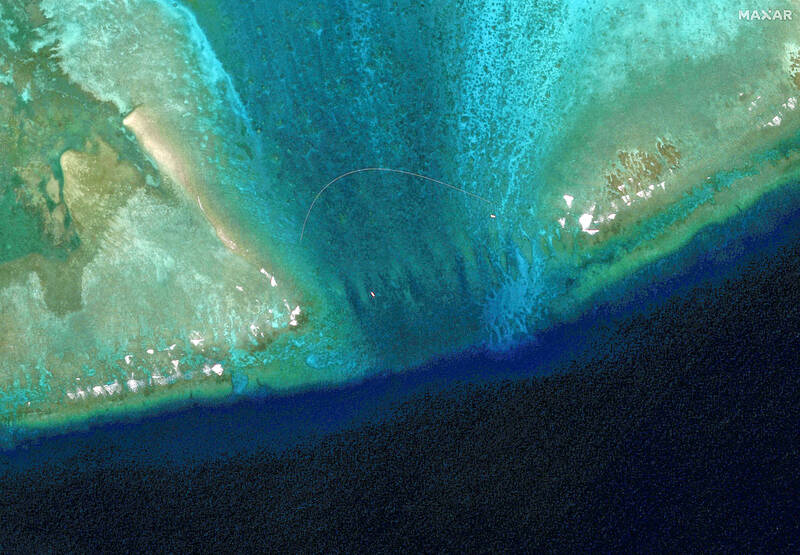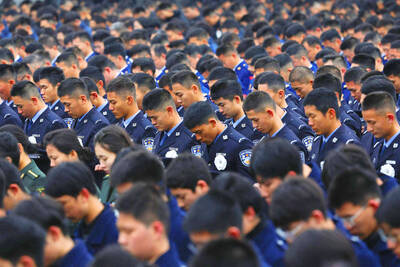Satellite images of the hotly disputed Scarborough Shoal (Huangyan Island, 黃岩島) in the South China Sea show a new floating barrier across its entrance, near where Philippine ships and Chinese coast guard vessels have had frequent run-ins.
One of the images taken by Maxar Technologies on Thursday last week and viewed by Reuters showed the barrier blocking the mouth of the shoal, where the Chinese coast guard last week claimed to have driven off a Philippine vessel “illegally intruding” into Beijing’s waters.
Manila, which last week deployed a Philippine Bureau of Fisheries and Aquatic Resources (BFAR) vessel to patrol the shoal and transport fuel to Filipino fishers in the area, said that China’s claims were “inaccurate” and that Manila’s activities there were lawful.

Photo: Maxar Technologies via Reuters
China claims the Scarborough Shoal, although it is inside the Philippines’ 200 nautical mile (370km) exclusive economic zone. An international arbitration tribunal in The Hague, Netherlands, in 2016 said that China’s claims had no legal basis — a decision Beijing has rejected.
That makes the atoll one of Asia’s most contested maritime features, and a flashpoint for diplomatic flare-ups over sovereignty and fishing rights.
The satellite image bolsters a report and video distributed by the Philippine Coast Guard on Sunday showing two Chinese coast guard inflatable boats deploying floating barriers at the shoal’s entrance on Thursday last week.
It said that a Chinese coast guard ship shadowed the BFAR vessel, conducted blocking maneuvers about 1.3 nautical miles off the shoal, and closely approached it.
“We can assume that [the barrier] is intended for Philippine government vessels because they install it every time they monitor our presence within the BDM vicinity,” Philippine Coast Guard spokesman Jay Tarriela said, referring to Bajo de Masinloc, Manila’s name for the shoal.
Chinese Ministry of Foreign Affairs spokeswoman Mao Ning (毛寧) said that Huangyan Island, China’s name for the shoal, was “China’s inherent territory.”
“Recently, the Philippine side has taken a series of actions to violate China’s sovereignty” in the shoal’s waters, she said. “China has to take necessary measures to firmly safeguard its territorial sovereignty, and maritime rights and interests.”
Another satellite image showed what Maxar Technologies described as “possible Chinese interception of a BFAR vessel” at the shoal.
China claims almost the entire South China Sea, a conduit for more than $3 trillion in annual ship commerce. Its territorial claims overlap with those of Taiwan, Philippines, Vietnam, Malaysia and Brunei.
“What we are seeing at the Scarborough Shoal now is likely the beginning of Beijing’s pushback against Manila’s pushback,” said Ian Storey, a senior fellow at Singapore’s ISEAS-Yusof Ishak Institute.
Since Philippine President Ferdinand Marcos Jr took office in June 2022, the Philippines has challenged China’s presence at the shoal and its attempts to stop the resupply of Filipino troops stationed at Second Thomas Shoal (Renai Shoal, 仁愛暗沙), he said.
“China’s attempts to prevent Filipino fishermen from fishing at Scarborough Shoal is absolutely illegal,” Storey said. “The 2016 arbitral tribunal ruling gave fishermen from both countries the right to [fish there]. Manila is merely supporting the legitimate rights of Filipino fishermen.”
The shoal is coveted for its bountiful fish stocks and a stunning turquoise lagoon that provides a safe haven for vessels during storms.
The Chinese removed the barrier a few hours after the BFAR vessel left, Tarriela said.
It was not clear from the photographs how robust the barrier was and whether it would have posed an obstacle to larger warships.
In an article on Sunday, China’s Global Times said that “the Philippines has abused and unilaterally sabotaged the foundation of Beijing’s goodwill to Manila” that allowed Filipino fishers to operate nearby, by working against China’s sovereignty and jurisdiction.
“If such provocations persist, China could be forced to take more effective measures to control the situation,” the article said, citing experts.

The Burmese junta has said that detained former leader Aung San Suu Kyi is “in good health,” a day after her son said he has received little information about the 80-year-old’s condition and fears she could die without him knowing. In an interview in Tokyo earlier this week, Kim Aris said he had not heard from his mother in years and believes she is being held incommunicado in the capital, Naypyidaw. Aung San Suu Kyi, a Nobel Peace Prize laureate, was detained after a 2021 military coup that ousted her elected civilian government and sparked a civil war. She is serving a

China yesterday held a low-key memorial ceremony for the 1937 Nanjing Massacre, with Chinese President Xi Jinping (習近平) not attending, despite a diplomatic crisis between Beijing and Tokyo over Taiwan. Beijing has raged at Tokyo since Japanese Prime Minister Sanae Takaichi last month said that a hypothetical Chinese attack on Taiwan could trigger a military response from Japan. China and Japan have long sparred over their painful history. China consistently reminds its people of the 1937 Nanjing Massacre, in which it says Japanese troops killed 300,000 people in what was then its capital. A post-World War II Allied tribunal put the death toll

‘NO AMNESTY’: Tens of thousands of people joined the rally against a bill that would slash the former president’s prison term; President Lula has said he would veto the bill Tens of thousands of Brazilians on Sunday demonstrated against a bill that advanced in Congress this week that would reduce the time former president Jair Bolsonaro spends behind bars following his sentence of more than 27 years for attempting a coup. Protests took place in the capital, Brasilia, and in other major cities across the nation, including Sao Paulo, Florianopolis, Salvador and Recife. On Copacabana’s boardwalk in Rio de Janeiro, crowds composed of left-wing voters chanted “No amnesty” and “Out with Hugo Motta,” a reference to the speaker of the lower house, which approved the bill on Wednesday last week. It is

FALLEN: The nine soldiers who were killed while carrying out combat and engineering tasks in Russia were given the title of Hero of the Democratic People’s Republic of Korea North Korean leader Kim Jong-un attended a welcoming ceremony for an army engineering unit that had returned home after carrying out duties in Russia, North Korean state media KCNA reported on Saturday. In a speech carried by KCNA, Kim praised officers and soldiers of the 528th Regiment of Engineers of the Korean People’s Army (KPA) for “heroic” conduct and “mass heroism” in fulfilling orders issued by the ruling Workers’ Party of Korea during a 120-day overseas deployment. Video footage released by North Korea showed uniformed soldiers disembarking from an aircraft, Kim hugging a soldier seated in a wheelchair, and soldiers and officials